checking oil KIA BORREGO 2017 Owners Manual
[x] Cancel search | Manufacturer: KIA, Model Year: 2017, Model line: BORREGO, Model: KIA BORREGO 2017Pages: 548, PDF Size: 36.78 MB
Page 223 of 548

Features of your vehicle
134
4
If dust or other pollutants accumulate
in the filter over a period of time, the
air flow from the air vents may
decrease, resulting in moisture accu-
mulation on the inside of the wind-
shield even when the outside (fresh)
air position is selected. If this hap-
pens, we recommend that the cli-
mate control air filter be replaced by
an authorized Kia dealer.
✽✽
NOTICE
Replace the filter according to the Maintenance Schedule.
If the car is being driven in severe
conditions such as dusty, rough
roads, more frequent climate con-
trol air filter inspections and
changes are required.
When the air flow rate suddenly decreases, we recommend that the
system be checked by an author-
ized Kia dealer.
Checking the amount of air
conditioner refrigerant andcompressor lubricant
When the amount of refrigerant is
low, the performance of the air con-
ditioning is reduced. Overfilling alsohas a bad influence on the air condi-tioning system.
Therefore, if abnormal operation is
found, we recommend that the sys-
tem be inspected by an authorized
Kia dealer. *: Your vehicle is filled with R-134a
according to the regulation in your
country at the time of producing.
You can find out which air condi-
tioning refrigerant is applied your
vehicle at the chapter 9, air condi-tioning system.
WARNING - Vehicles
equipped with R-134a*
Because the refriger-
ant is at very high
pressure, the air con-ditioning system
should only be serv-
iced by trained and certified
technicians. It is important thatthe correct type and amount of
oil and refrigerant is used.
Otherwise, it may cause dam-
age to the vehicle and personal
injury.
Page 443 of 548
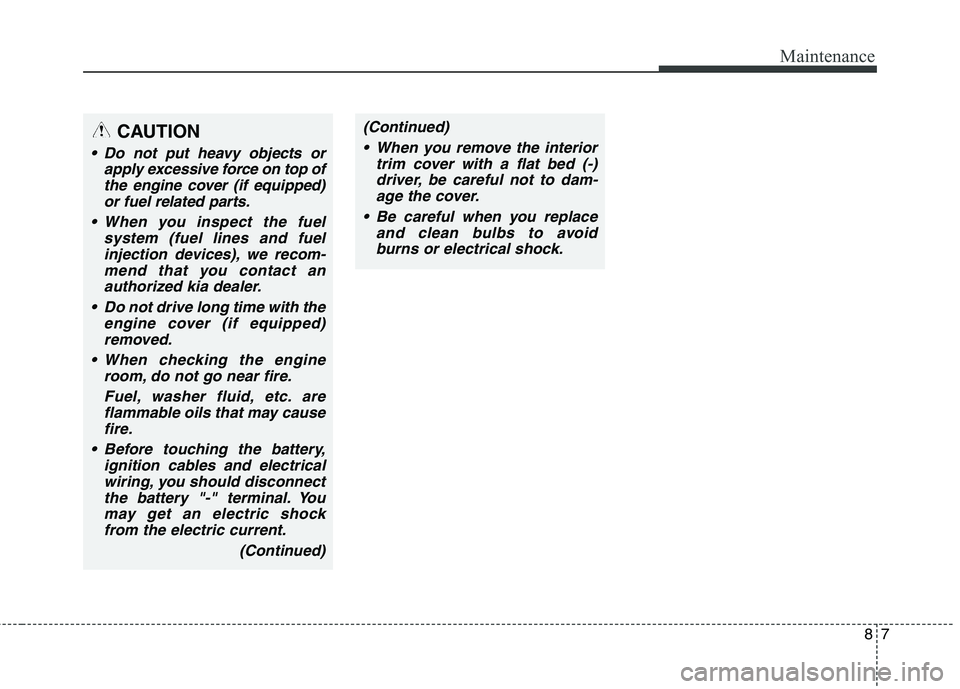
87
Maintenance
CAUTION
Do not put heavy objects orapply excessive force on top ofthe engine cover (if equipped)or fuel related parts.
When you inspect the fuel system (fuel lines and fuelinjection devices), we recom- mend that you contact anauthorized kia dealer.
Do not drive long time with the engine cover (if equipped)removed.
When checking the engine room, do not go near fire.
Fuel, washer fluid, etc. areflammable oils that may causefire.
Before touching the battery, ignition cables and electricalwiring, you should disconnect the battery "-" terminal. Youmay get an electric shockfrom the electric current.
(Continued)
(Continued) When you remove the interior trim cover with a flat bed (-)driver, be careful not to dam- age the cover.
Be careful when you replace and clean bulbs to avoidburns or electrical shock.
Page 444 of 548
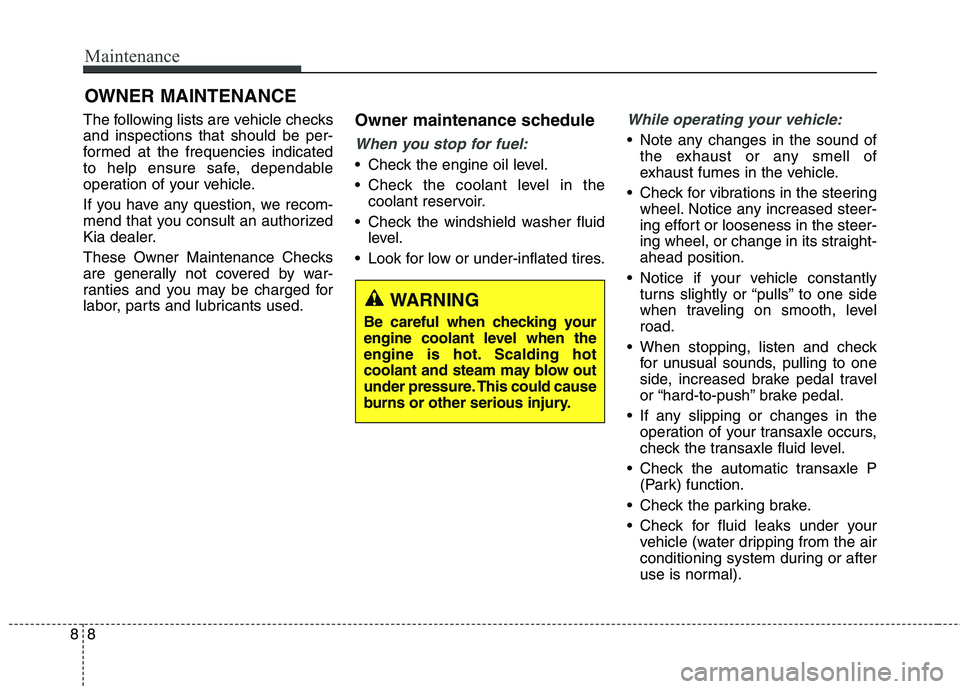
Maintenance
8
8
OWNER MAINTENANCE
The following lists are vehicle checks and inspections that should be per-
formed at the frequencies indicated
to help ensure safe, dependable
operation of your vehicle.
If you have any question, we recom-
mend that you consult an authorized
Kia dealer.
These Owner Maintenance Checks
are generally not covered by war-
ranties and you may be charged for
labor, parts and lubricants used. Owner maintenance schedule
When you stop for fuel:
Check the engine oil level.
Check the coolant level in the
coolant reservoir.
Check the windshield washer fluid level.
Look for low or under-inflated tires.
While operating your vehicle:
Note any changes in the sound of the exhaust or any smell of
exhaust fumes in the vehicle.
Check for vibrations in the steering wheel. Notice any increased steer-
ing effort or looseness in the steer-
ing wheel, or change in its straight-ahead position.
Notice if your vehicle constantly turns slightly or “pulls” to one side
when traveling on smooth, levelroad.
When stopping, listen and check for unusual sounds, pulling to one
side, increased brake pedal travel
or “hard-to-push” brake pedal.
If any slipping or changes in the operation of your transaxle occurs,
check the transaxle fluid level.
Check the automatic transaxle P (Park) function.
Check the parking brake.
Check for fluid leaks under your vehicle (water dripping from the air
conditioning system during or after
use is normal).
WARNING
Be careful when checking your
engine coolant level when the
engine is hot. Scalding hot
coolant and steam may blow out
under pressure. This could cause
burns or other serious injury.
Page 457 of 548
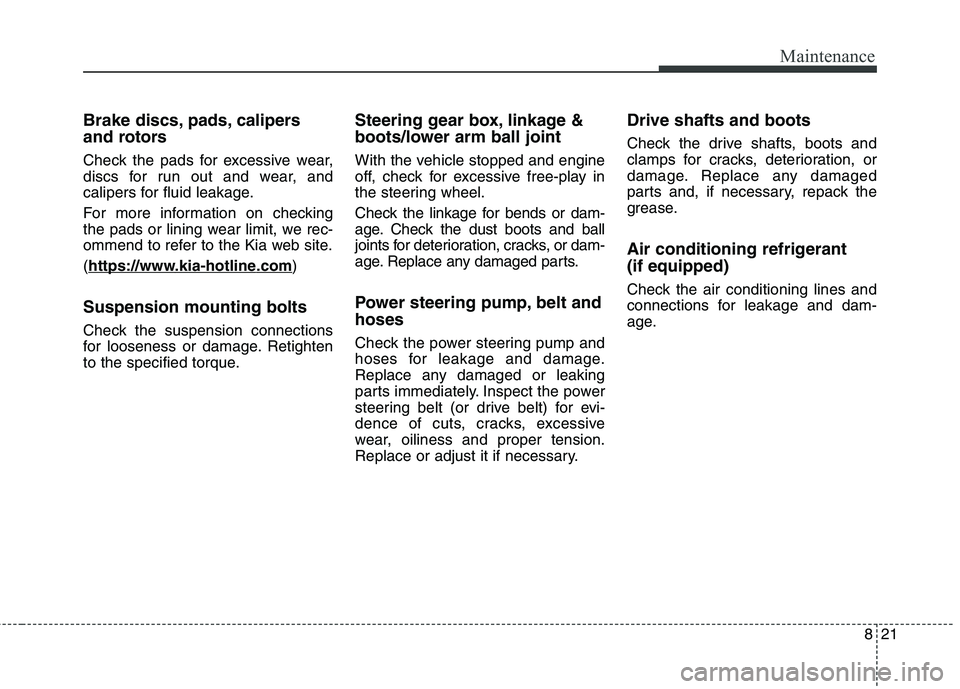
821
Maintenance
Brake discs, pads, calipers
and rotors
Check the pads for excessive wear,
discs for run out and wear, and
calipers for fluid leakage.
For more information on checking
the pads or lining wear limit, we rec-
ommend to refer to the Kia web site. (https://www
.kia-hotline.com)
Suspension mounting bolts
Check the suspension connections
for looseness or damage. Retighten
to the specified torque. Steering gear box, linkage &
boots/lower arm ball joint
With the vehicle stopped and engine
off, check for excessive free-play in
the steering wheel.
Check the linkage for bends or dam-
age. Check the dust boots and ball
joints for deterioration, cracks, or dam-
age. Replace any damaged parts.
Power steering pump, belt and hoses
Check the power steering pump and
hoses for leakage and damage.
Replace any damaged or leaking
parts immediately. Inspect the power
steering belt (or drive belt) for evi-
dence of cuts, cracks, excessive
wear, oiliness and proper tension.
Replace or adjust it if necessary.Drive shafts and boots
Check the drive shafts, boots and
clamps for cracks, deterioration, or
damage. Replace any damaged
parts and, if necessary, repack the
grease.
Air conditioning refrigerant (if equipped)
Check the air conditioning lines and
connections for leakage and dam-
age.
Page 458 of 548
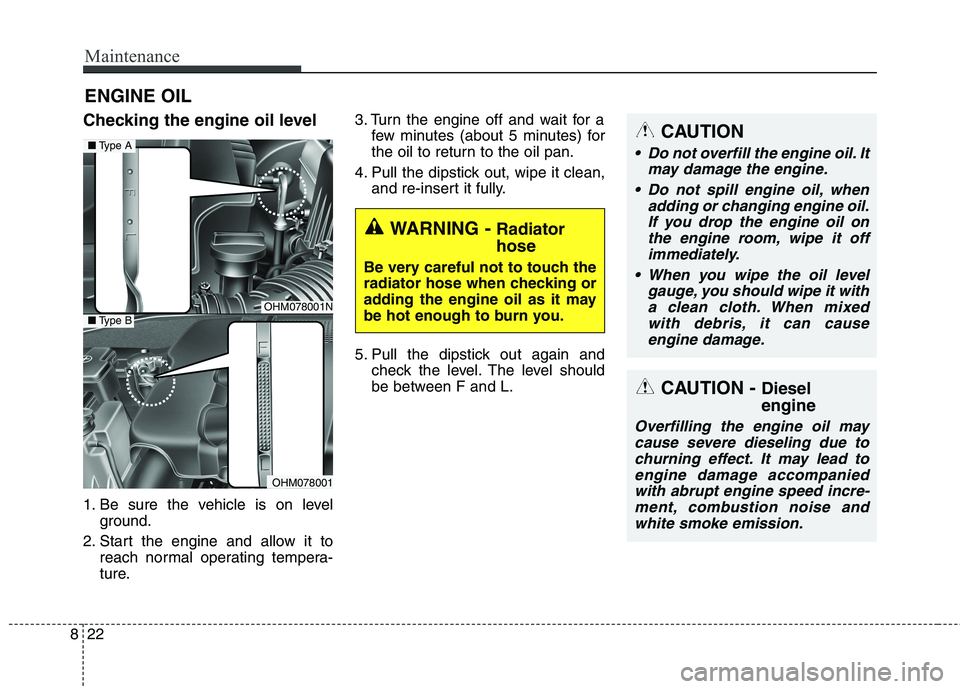
Maintenance
22
8
ENGINE OIL
Checking the engine oil level
1. Be sure the vehicle is on level ground.
2. Start the engine and allow it to reach normal operating tempera-
ture. 3. Turn the engine off and wait for a
few minutes (about 5 minutes) for
the oil to return to the oil pan.
4. Pull the dipstick out, wipe it clean, and re-insert it fully.
5. Pull the dipstick out again and check the level. The level should
be between F and L.
WARNING - Radiator hose
Be very careful not to touch the
radiator hose when checking or
adding the engine oil as it may
be hot enough to burn you.
CAUTION
Do not overfill the engine oil. It may damage the engine.
Do not spill engine oil, when adding or changing engine oil.If you drop the engine oil onthe engine room, wipe it offimmediately.
When you wipe the oil level gauge, you should wipe it witha clean cloth. When mixedwith debris, it can causeengine damage.
CAUTION - Diesel engine
Overfilling the engine oil may
cause severe dieseling due tochurning effect. It may lead to engine damage accompaniedwith abrupt engine speed incre-ment, combustion noise andwhite smoke emission.
OHM078001N
OHM078001
■ Type A
■Type B
Page 463 of 548
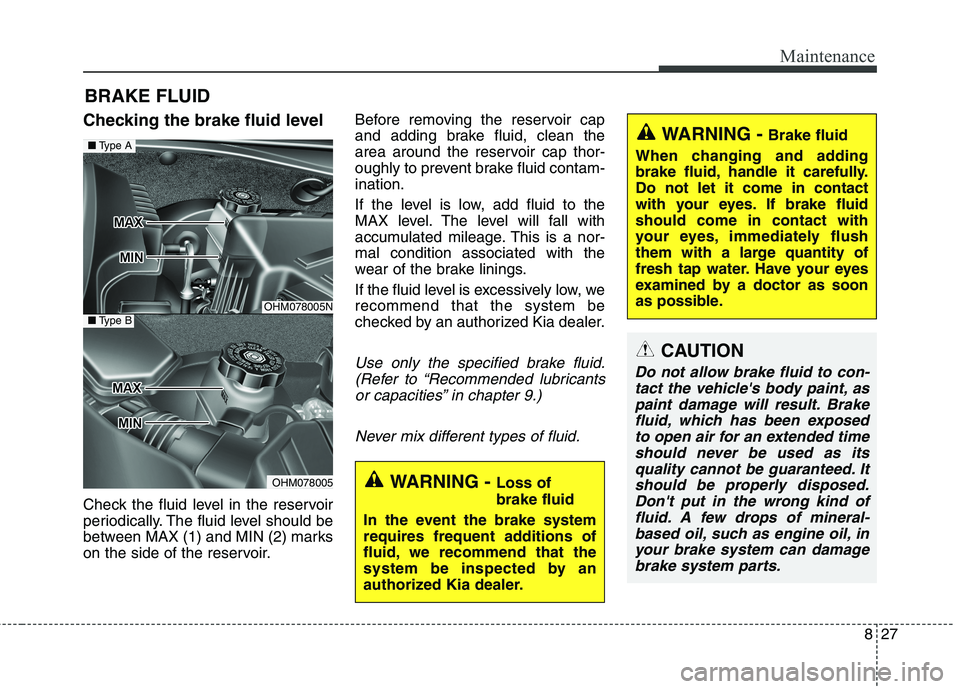
827
Maintenance
BRAKE FLUID
Checking the brake fluid level
Check the fluid level in the reservoir
periodically. The fluid level should be
between MAX (1) and MIN (2) marks
on the side of the reservoir. Before removing the reservoir cap
and adding brake fluid, clean the
area around the reservoir cap thor-
oughly to prevent brake fluid contam-ination.
If the level is low, add fluid to the
MAX level. The level will fall with
accumulated mileage. This is a nor-mal condition associated with the
wear of the brake linings.
If the fluid level is excessively low, we recommend that the system be
checked by an authorized Kia dealer.
Use only the specified brake fluid.
(Refer to “Recommended lubricantsor capacities” in chapter 9.)
Never mix different types of fluid.
WARNING - Brake fluid
When changing and adding
brake fluid, handle it carefully.Do not let it come in contact
with your eyes. If brake fluidshould come in contact with
your eyes, immediately flush
them with a large quantity of
fresh tap water. Have your eyes
examined by a doctor as soon
as possible.
WARNING - Loss of brake fluid
In the event the brake system
requires frequent additions of
fluid, we recommend that the
system be inspected by an
authorized Kia dealer.
CAUTION
Do not allow brake fluid to con- tact the vehicle's body paint, aspaint damage will result. Brakefluid, which has been exposed to open air for an extended timeshould never be used as itsquality cannot be guaranteed. It should be properly disposed.Don't put in the wrong kind offluid. A few drops of mineral- based oil, such as engine oil, inyour brake system can damagebrake system parts.
OHM078005N
OHM078005
■ Type A
■Type B
Page 464 of 548
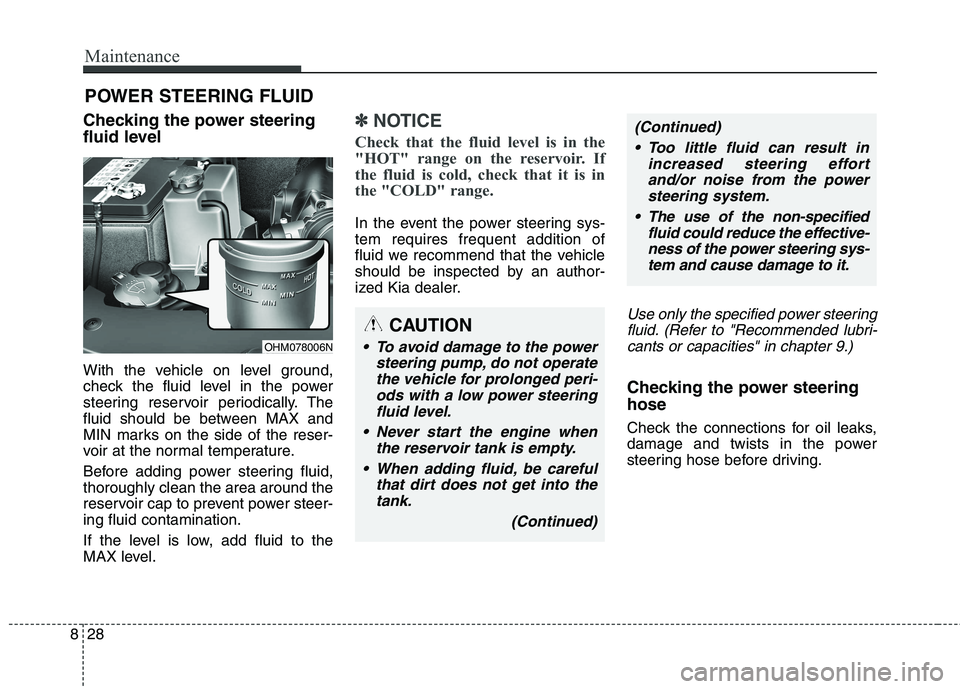
Maintenance
28
8
POWER STEERING FLUID
Checking the power steering
fluid level
With the vehicle on level ground,
check the fluid level in the power
steering reservoir periodically. The
fluid should be between MAX and
MIN marks on the side of the reser-
voir at the normal temperature.
Before adding power steering fluid, thoroughly clean the area around the
reservoir cap to prevent power steer-ing fluid contamination.
If the level is low, add fluid to the
MAX level.
✽✽ NOTICE
Check that the fluid level is in the
"HOT" range on the reservoir. If
the fluid is cold, check that it is in
the "COLD" range.
In the event the power steering sys- tem requires frequent addition of
fluid we recommend that the vehicle
should be inspected by an author-
ized Kia dealer.
Use only the specified power steering fluid. (Refer to "Recommended lubri-cants or capacities" in chapter 9.)
Checking the power steering hose
Check the connections for oil leaks,
damage and twists in the power
steering hose before driving.
CAUTION
To avoid damage to the power steering pump, do not operatethe vehicle for prolonged peri-ods with a low power steeringfluid level.
Never start the engine when the reservoir tank is empty.
When adding fluid, be careful that dirt does not get into thetank.
(Continued)
(Continued) Too little fluid can result in increased steering effortand/or noise from the power steering system.
The use of the non-specified fluid could reduce the effective-ness of the power steering sys-tem and cause damage to it.
OHM078006N
Page 476 of 548
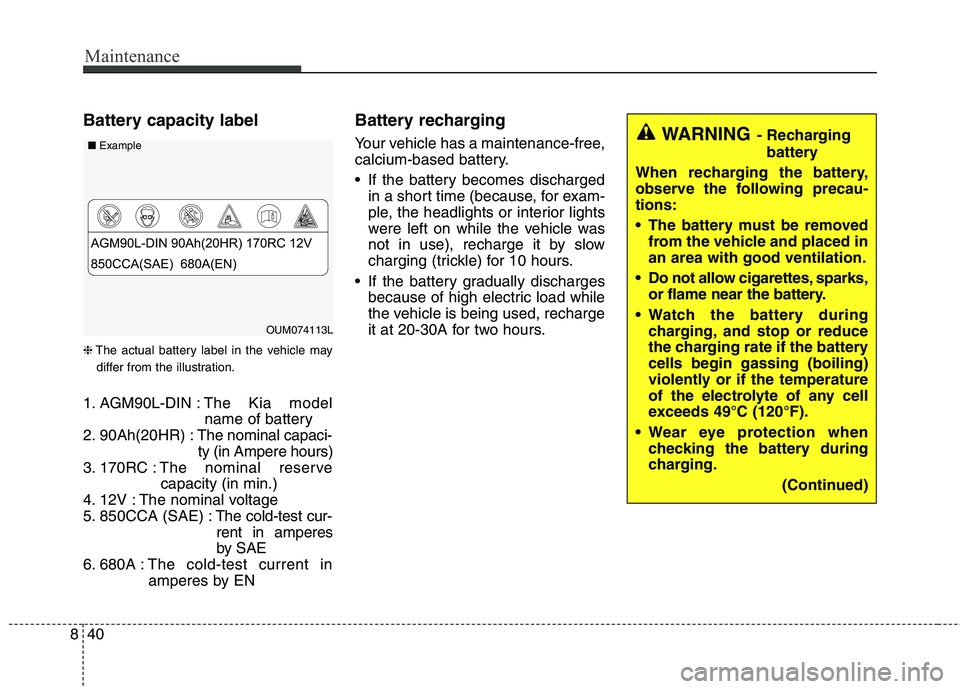
Maintenance
40
8
Battery capacity label ❈ The actual battery label in the vehicle may
differ from the illustration.
1. AGM90L-DIN : The Kia model
name of battery
2. 90Ah(20HR) : The nominal capaci-
ty (in Ampere hours)
3. 170RC : The nominal reserve
capacity (in min.)
4. 12V : The nominal voltage
5. 850CCA (SAE) : The cold-test cur-
rent in amperes
by SAE
6. 680A : The cold-test current in
amperes by EN Battery recharging
Your vehicle has a maintenance-free,
calcium-based battery.
If the battery becomes discharged
in a short time (because, for exam-
ple, the headlights or interior lights
were left on while the vehicle was
not in use), recharge it by slow
charging (trickle) for 10 hours.
If the battery gradually discharges because of high electric load while
the vehicle is being used, recharge
it at 20-30A for two hours.
OUM074113L
■
Example
WARNING - Recharging
battery
When recharging the battery,
observe the following precau-tions:
The battery must be removed from the vehicle and placed in an area with good ventilation.
Do not allow cigarettes, sparks, or flame near the battery.
Watch the battery during charging, and stop or reduce
the charging rate if the batterycells begin gassing (boiling)
violently or if the temperature
of the electrolyte of any cell
exceeds 49°C (120°F).
Wear eye protection when checking the battery during
charging.
(Continued)
Page 540 of 548
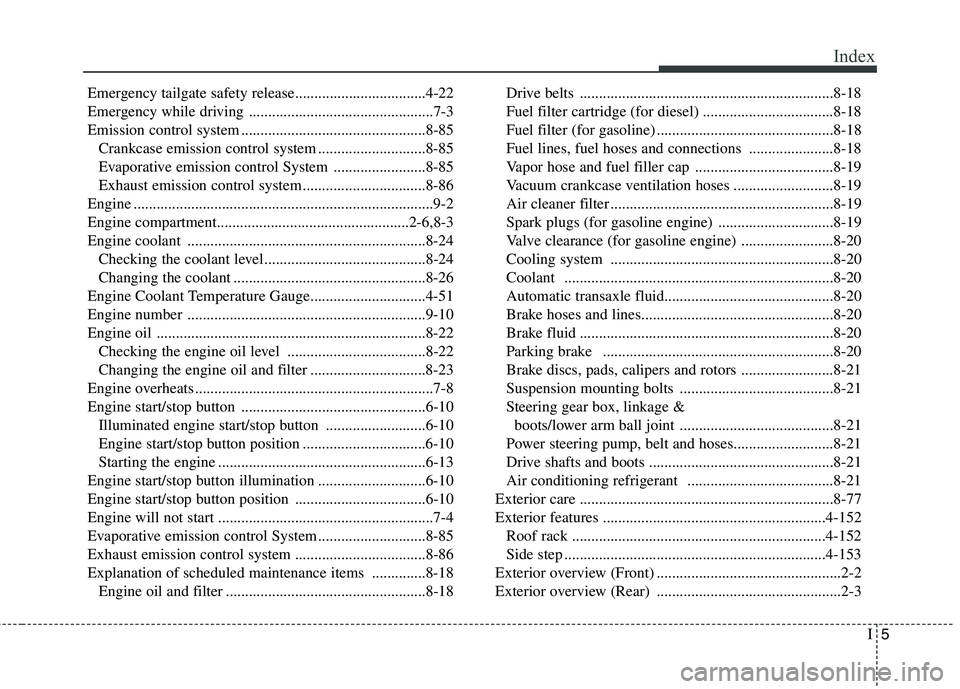
I5
Index
Emergency tailgate safety release..................................4-22
Emergency while driving ................................................7-3
Emission control system ................................................8-85
Crankcase emission control system ............................8-85
Evaporative emission control System ........................8-85
Exhaust emission control system ................................8-86
Engine ..............................................................................9-2
Engine compartment..................................................2-6,8-3
Engine coolant ..............................................................8-24 Checking the coolant level..........................................8-24
Changing the coolant ..................................................8-26
Engine Coolant Temperature Gauge..............................4-51
Engine number ..............................................................9-10
Engine oil ......................................................................8-22 Checking the engine oil level ....................................8-22
Changing the engine oil and filter ..............................8-23
Engine overheats ..............................................................7-8
Engine start/stop button ................................................6-10 Illuminated engine start/stop button ..........................6-10
Engine start/stop button position ................................6-10
Starting the engine ......................................................6-13
Engine start/stop button illumination ............................6-10
Engine start/stop button position ..................................6-10
Engine will not start ........................................................7-4
Evaporative emission control System ............................8-85
Exhaust emission control system ..................................8-86
Explanation of scheduled maintenance items ..............8-18 Engine oil and filter ....................................................8-18 Drive belts ..................................................................8-18
Fuel filter cartridge (for diesel) ..................................8-18
Fuel filter (for gasoline) ..............................................8-18
Fuel lines, fuel hoses and connections ......................8-18
Vapor hose and fuel filler cap ....................................8-19
Vacuum crankcase ventilation hoses ..........................8-19
Air cleaner filter ..........................................................8-19
Spark plugs (for gasoline engine) ..............................8-19
Valve clearance (for gasoline engine) ........................8-20
Cooling system ..........................................................8-20Coolant ......................................................................8-20Automatic transaxle fluid............................................8-20
Brake hoses and lines..................................................8-20
Brake fluid ..................................................................8-20
Parking brake ............................................................8-20
Brake discs, pads, calipers and rotors ........................8-21
Suspension mounting bolts ........................................8-21
Steering gear box, linkage & boots/lower arm ball joint ........................................8-21
Power steering pump, belt and hoses..........................8-21
Drive shafts and boots ................................................8-21
Air conditioning refrigerant ......................................8-21
Exterior care ..................................................................8-77
Exterior features ..........................................................4-152 Roof rack ..................................................................4-152
Side step ....................................................................4-153
Exterior overview (Front) ................................................2-2
Exterior overview (Rear) ................................................2-3
Page 544 of 548
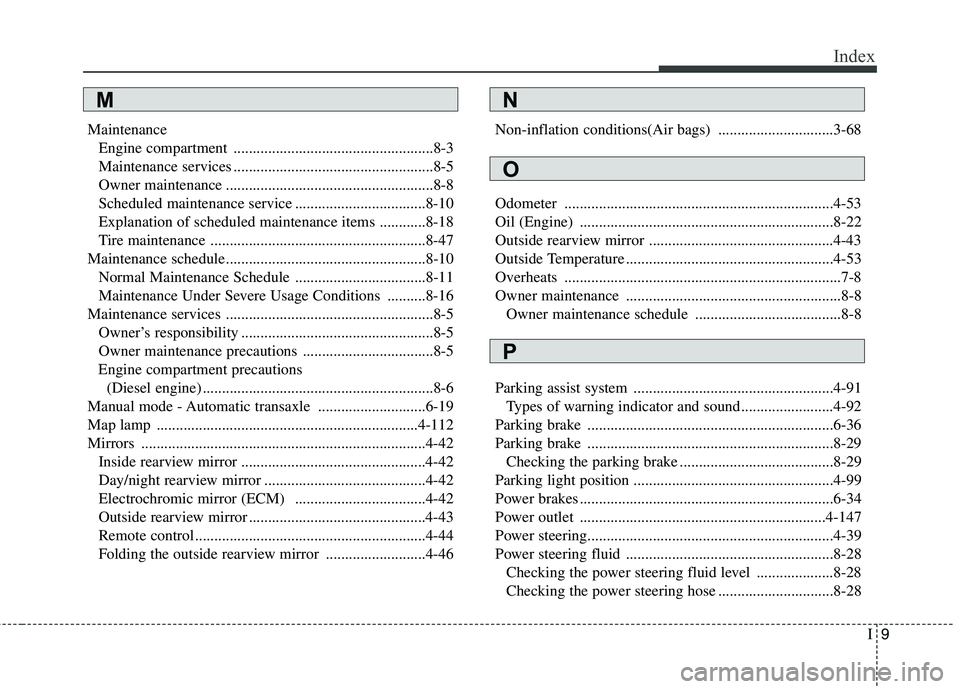
I9
Index
Maintenance
Engine compartment ....................................................8-3
Maintenance services ....................................................8-5
Owner maintenance ......................................................8-8
Scheduled maintenance service ..................................8-10
Explanation of scheduled maintenance items ............8-18
Tire maintenance ........................................................8-47
Maintenance schedule....................................................8-10 Normal Maintenance Schedule ..................................8-11
Maintenance Under Severe Usage Conditions ..........8-16
Maintenance services ......................................................8-5 Owner’s responsibility ..................................................8-5
Owner maintenance precautions ..................................8-5
Engine compartment precautions (Diesel engine) ............................................................8-6
Manual mode - Automatic transaxle ............................6-19
Map lamp ....................................................................4-112
Mirrors ..........................................................................4-42 Inside rearview mirror ................................................4-42
Day/night rearview mirror ..........................................4-42
Electrochromic mirror (ECM) ..................................4-42
Outside rearview mirror ..............................................4-43
Remote control ............................................................4-44
Folding the outside rearview mirror ..........................4-46 Non-inflation conditions(Air bags) ..............................3-68
Odometer ......................................................................4-53
Oil (Engine) ..................................................................8-22
Outside rearview mirror ................................................4-43
Outside Temperature ......................................................4-53
Overheats ........................................................................7-8
Owner maintenance ........................................................8-8
Owner maintenance schedule ......................................8-8
Parking assist system ....................................................4-91 Types of warning indicator and sound........................4-92
Parking brake ................................................................6-36
Parking brake ................................................................8-29 Checking the parking brake ........................................8-29
Parking light position ....................................................4-99
Power brakes ..................................................................6-34
Power outlet ................................................................4-147
Power steering................................................................4-39
Power steering fluid ......................................................8-28 Checking the power steering fluid level ....................8-28
Checking the power steering hose ..............................8-28
M
O
N
P